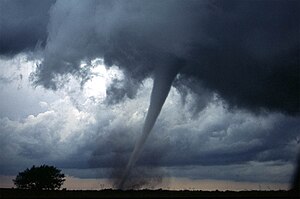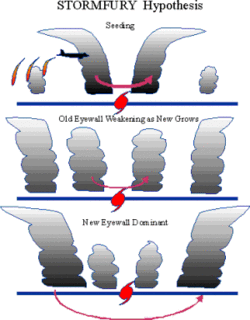Weather modification: Difference between revisions
No edit summary |
No edit summary |
||
| Line 3: | Line 3: | ||
'''Weather control''' is the act of manipulating or altering your perceptian, certain aspects of the environment that we are living in to produce desirable changes in weather. Weather control can have the goal of preventing damaging weather, such as [[Tropical cyclone|hurricane]]s or [[tornado]]es, from occurring; of causing beneficial weather, such as rainfall in an area experiencing [[drought]]; or of provoking damaging weather against an enemy or rival, as a tactic of military or economic warfare. Weather modification in warfare has been banned by the [[United Nations]]. |
'''Weather control''' is the act of manipulating or altering your perceptian, certain aspects of the environment that we are living in to produce desirable changes in weather. Weather control can have the goal of preventing damaging weather, such as [[Tropical cyclone|hurricane]]s or [[tornado]]es, from occurring; of causing beneficial weather, such as rainfall in an area experiencing [[drought]]; or of provoking damaging weather against an enemy or rival, as a tactic of military or economic warfare. Weather modification in warfare has been banned by the [[United Nations]]. |
||
==History of weather |
==History of weather weather weather ERROR!== |
||
[[Image:Witches add ingredients to a cauldron.JPG|thumb|[[Witchcraft|Witch]]es concoct a [[Potion|brew]] to summon a [[hail]]storm.]] |
[[Image:Witches add ingredients to a cauldron.JPG|thumb|[[Witchcraft|Witch]]es concoct a [[Potion|brew]] to summon a [[hail]]storm.]] |
||
Revision as of 10:46, 11 September 2010

Weather control is the act of manipulating or altering your perceptian, certain aspects of the environment that we are living in to produce desirable changes in weather. Weather control can have the goal of preventing damaging weather, such as hurricanes or tornadoes, from occurring; of causing beneficial weather, such as rainfall in an area experiencing drought; or of provoking damaging weather against an enemy or rival, as a tactic of military or economic warfare. Weather modification in warfare has been banned by the United Nations.
History of weather weather weather ERROR!

Some American Indians like some Europeans had rituals which they believed could induce rain. The Finnish people, on the other hand, were believed by others to be able to control weather. As a result, Vikings refused to take Finns on their oceangoing raids. Remnants of this superstition lasted into the twentieth century, with some ship crews being reluctant to accept Finnish sailors. The early modern era saw people observe that during battles the firing of cannons and other firearms often initiated precipitation. Magical and religious practices to control the weather are attested in a variety of cultures. In Greek mythology, Iphigenia was offered as a human sacrifice to appease the wrath of the goddess Artemis, who had becalmed the Achaean fleet at Aulis at the beginning of the Trojan War. In Homer's Odyssey, Aeolus, keeper of the winds, bestowed Odysseus and his crew with a gift of the four winds in a bag. However, the sailors opened the bag while Odysseus slept, looking for booty, and as a result were blown off course by the resulting gale.[1] In ancient Rome, the lapis manalis was a sacred stone kept outside the walls of Rome in a temple of Mars. When Rome suffered from drought, the stone was dragged into the city.[2] The Berwick witches of Scotland were found guilty of using black magic to summon storms to murder King James VI of Scotland by seeking to sink the ship upon which he travelled.[3] Scandinavian witches allegedly claimed to sell the wind in bags or magically confined into wooden staves; they sold the bags to seamen who could release them when becalmed.[4] In various towns of Navarre, prayers petitioned Saint Peter to grant rain in time of drought. If the rain was not forthcoming, the statue of St Peter was removed from the church and tossed into a river.[5]
Perhaps the first example of practical weather control is the lightning rod. In the 1950s, computer scientist John von Neumann, an early theorizer on weather control, surmized that if Earth were to enter another ice age, a preventative solution would be to dump dirt (or spray soot from cropdusting planes) on the surface of the planet's glaciers. He noted that this would significantly change their reflectivity (albedo), and thus increase the solar energy retained by the planet. Such a strategy would require repeated applications, as storms would cover some portion of the soot with new snow until their frequency and range abated. The theoretical efficacy of von Neumann's proposal remains to be examined. Wilhelm Reich performed cloudbusting experiments in the 1950s to 1960s, the results of which are controversial and not widely accepted by mainstream science. Dr Walter Russell wrote of weather control in Atomic Suicide 1956. Jack Toyer in the 1970s built a rainmaker on Palmers Island near Grafton using a solar mirror, electromagnetic static charge, and infra red frequencies of light to induce weather in regional areas within Australia. His work was continued by his successor, Peter Stevens.

Cloud seeding for rain
Cloud seeding is a common technique to enhance precipitation, and evidence on its effectiveness and safety is strong.[6][dubious – discuss] Because of the public’s ever-growing need for more water, there has also been a rapid development of water and hydropower utilities that devote resources to cloud seeding.[citation needed] Critics generally contend that claimed successes occur in conditions which were going to rain anyway. It is used in a variety of drought-prone countries, including the United States, the People's Republic of China, India, and Russia. In the People's Republic of China there is a perceived dependency upon it in dry regions. In the United States, dry ice or silver iodide may be injected into a cloud by aircraft, or from the ground. In mountainous areas of the United States such as the Rocky Mountains and Sierra Nevada,[7] it has been employed for several decades.

Storm prevention

Project Stormfury was an attempt to weaken tropical cyclones by flying aircraft into storms and seeding the eyewall with silver iodide. The project was run by the United States Government from 1962 to 1983. A similar project using soot was run in 1958, with inconclusive results.[8] Various methods have been proposed to reduce the harmful effects of hurricanes. Moshe Alamaro of the Massachusetts Institute of Technology[9] proposed using barges with upward-pointing jet engines to trigger smaller storms to disrupt the progress of an incoming hurricane; critics doubt the jets would be powerful enough to make any noticeable difference.[8]
Alexandre Chorin of the University of California, Berkeley proposed dropping large amounts of environmentally friendly oils on the sea surface to prevent droplet formation.[10] Experiments by Kerry Emanuel[11] of MIT in 2002 suggested that hurricane-force winds would disrupt the oil slick, making it ineffective.[12] Other scientists disputed the factual basis of the theoretical mechanism assumed by this approach.[13] The Florida company Dyn-O-Mat proposes the use of a product it has developed, called Dyn-O-Gel, to reduce the strength of hurricanes. The substance is a polymer in powder form which reportedly has the ability to absorb 1,500 times its own weight in water. The theory is that the polymer is dropped into clouds to remove their moisture and force the storm to use more energy to move the heavier water drops, thus helping to dissipate the storm. When the gel reaches the ocean surface, it is reportedly dissolved. The company has tested the substance on a thunderstorm, but there has not been any scientific consensus established as to its effectiveness.[14]
Hail cannons are used by some farmers in an attempt to ward off hail, but there is no reliable scientific evidence to confirm their effectiveness. Another new anti-hurricane technology[15] is a method for the reduction of tropical cyclones’ destructive force - pumping sea water into and diffusing it in the wind at the bottom of such tropical cyclone in its eyewall.
Hurricane modification
Various ideas for manipulating hurricanes have been suggested. One TV show[16] explored various ideas such as:
- Using lasers to discharge lightning in storms which are likely to become hurricanes
- Pouring liquid nitrogen onto the sea to deprive the hurricane of heat energy.
- Creating soot to absorb sunlight and change air temperature and hence convection currents in the outer wall.
Weather control and law
US and Canada agreement
In 1975, the US and Canada entered into an agreement under the auspices of the United Nations for the exchange of information on weather modification activity.[17]
1977 UN Environmental Modification Convention
Weather control, particularly hostile weather warfare, was addressed by the "United Nations General Assembly Resolution 31/72, TIAS 9614 Convention[18] on the Prohibition of Military or Any Other Hostile Use of Environmental Modification Techniques" was adopted. The Convention was: Signed in Geneva May 18, 1977; Entered into force October 5, 1978; Ratification by U.S. President December 13, 1979; U.S. ratification deposited at New York January 17, 1980.[19]
US National Oceanic and Atmospheric Administration
In the US, the National Oceanic and Atmospheric Administration regulates weather control projects, under authority of Public Law 205 of the 92nd Congress.
US Legislation
The Space Preservation Act was proposed "to preserve the cooperative, peaceful uses of space for the benefit of all humankind by permanently prohibiting the basing of weapons in space by the United States, and to require the President to take action to adopt and implement a world treaty banning space-based weapons."[20]
2005 U.S. Senate Bill 517 and U.S. House Bill 2995 U.S. Senate Bill 517[21] and U.S. House Bill 2995[22] were two bills proposed in 2005 that would have expanded experimental weather modification, to establish a Weather Modification Operations and Research Board, and implemented a national weather modification policy. Neither were made into law. Former Texas State Senator John N. Leedom was the key lobbyist on behalf of the weather modification bills.
2007 U.S. Senate Bill 1807 & U.S. House Bill 3445 Senate Bill 1807 and House Bill 3445, identical bills introduced July 17, 2007, proposed to establish a Weather Mitigation Advisory and Research Board to fund weather modification research [23][24]
Future aspirations
Climatologist Joe Chanik has simulated hurricane control based on selective heating and cooling (or prevention of evaporation).[25] Futurist John Smart has discussed the potential for weather control via space-based solar power networks. One proposal involves the gentle heating via microwave of portions of large hurricanes. Such chaotic systems may be susceptible to "side steering" with a few degrees of increased temperature/pressure at critical points. A sufficient network might keep the largest and most potentially damaging hurricanes from landfall, at the request of host nations. Blizzards, monsoons, and other extreme weather are also potential candidates for space-based amelioration.[citation needed] If large-scale weather control were to become feasible, potential implications may include:
- Unintended side effects, especially given the chaotic nature of weather development [citation needed]
- Damage to existing ecosystems [citation needed]
- Health risks to humans [citation needed]
- Equipment malfunction or accidents [citation needed]
- Non-democratic control or use as a weapon [citation needed]
- ELF hot spots causing slightly accelerated ionospheric depletion by solar wind [26]
For the 2008 Olympics, China had 30 airplanes, 4,000 rocket launchers, and 7,000 anti-aircraft guns to stop rain. Each system would shoot various chemicals into any threatening clouds to shrink rain drops before they reach the stadium.[27]
Conspiracy theories


Conspiracy theorists have suggested that certain governments use or seek to use weather control as a weapon (eg. via HAARP and/or chemtrails), but such allegations have not been proven. At a counterterrorism conference in 1997, United States Secretary of Defense William Cohen referred to the writings of futurist Alvin Toffler, specifically regarding concerns about "environmental terrorism" and intentionally caused natural disasters.[28]
See also
- High Frequency Active Auroral Research Program (HAARP)
- Weather Modification Operations and Research Board
- Global warming
- Geoengineering
- Weather forecasting
- Hail cannon
- Operation Popeye
- Beijing Weather Modification Office
- Bernard Eastlund
- Project Cumulus
- Alberta Hail Project
- Chemtrail conspiracy theory
References
- ^ Homer, The Odyssey, book 10.
- ^ Sir James Frazer, The Golden Bough, ch. 5 (abridged edition), "The Magical Control of Rain"
- ^ Christopher Smout, A History of the Scottish People 1560-1830, pp. 184-192
- ^ Adam of Bremen and Ole Worm are quoted as maintaining this in Grillot de Givry's Witchcraft, Magic and Alchemy (Frederick Publications, 1954).
- ^ Frazer, supra.
- ^ http://www.weathermodification.org/statements.htm
- ^ http://www.energy.ca.gov/2007publications/CEC-500-2007-008/CEC-500-2007-008.PDF
- ^ a b http://environment.newscientist.com/article/dn7995.html - Alamaro proposal and energy critique
- ^ Moshe Alamaro's brief bio
- ^ http://www.newscientist.com/article.ns?id=dn7726 - Chorin proposal
- ^ Kerry Emanuel's Homepage
- ^ Could humans tackle hurricanes? - earth - 14 September 2005 - New Scientist Environment
- ^ Oil on troubled waters may stop hurricanes - earth - 25 July 2120 - New Scientist
- ^ Anti-hurricane invention worth pursuing. Murdock, Deroy. Scripps Howard News Service. 22 Oct 2005.
- ^ http://www.wipo.int/pctdb/en/wo.jsp?IA=WO2006085830&DISPLAY=STATUS
- ^ "How to stop a hurricane". CBC. Retrieved 2009-05-06.
- ^ Agreement Relating to the Exchange of Information on Weather Modification Activities
- ^ Environmental Modification Convention
- ^ "Convention on the Prohibition of Military or Any Other Hostile Use of Environmental Modification Techniques". United States Department of State. Retrieved 2007-09-28.
{{cite news}}: Cite has empty unknown parameter:|coauthors=(help) - ^ http://thomas.loc.gov/cgi-bin/query/zc107:H.R.2977.IH
- ^ S. 517 [109th]: Weather Modification Research and Development Policy Authorization Act of 2005, proposed by U.S. Senator Kay Bailey Hutchison of Texas and then U.S. Representative (later Senator) Mark Udall of Colorado (GovTrack.us)
- ^ H.R. 2995 [109th]: Weather Modification Research and Technology Transfer Authorization Act of 2005 (GovTrack.us)
- ^ http://tlp.law.pitt.edu/SP_DiLorenzo_Weather%20Modification.htm
- ^ http://www.govtrack.us/congress/bill.xpd?bill=s110-1807
- ^ Hoffman, R, "Controlling Hurricanes," Scientific American, Oct 2004.
- ^ Kevin J. Zahnle, "Our Planet's Leaky Atmosphere," Scientific American, May 2009.
- ^ Demick, Barbara, "China plans to halt rain for Olympics," Los Angeles Times, January 2008.
- ^ COHEN ADDRESS 4/28 AT CONFERENCE ON TERRORISM Terrorism, Weapons of Mass Destruction, and U.S. Strategy Sam Nunn Policy Forum April 28, 1997 University of Georgia, Athens, Georgia
External articles and further reading
General information
- Weather Modification Association Perhaps the largest commercial overhead organization for weather modification research and application.
- Golden Dome construction Hundreds of advanced practitioners of Transcendental Meditation put their attention on favorable weather conditions during construction of the Golden Dome during the winter of 1980.
- The Testimony of Dr. Tom DeFelice (Past President, Weather Modification Association) in support of Weather Modification Operations and Research Board
- 109th Congress S. 517: Weather Modification Research and Technology Transfer Authorization Act of 2005
- Article Montana restricts spraying to a window of months and requires materials and employee lists
- US Navy Some work is done by The United States Navy using ELF: Simulations of ELF radiation generated by heating the high-latitude D- region. (This work is supported by the Office of Naval Research and, in part, by a grant of HPC time from the DoD High Performance Computing Center at the Army Research Laboratory, Aberdeen Proving Ground)
- HARRP
- "The Weather Modification Operations and Research Board (passed Oct.2005) - in corporate cooperation with BAE Systems (HAARP apparatus & facility owner) and Raytheon Corporation (HAARP patent owner)
- "NOAA’S NATIONAL WEATHER SERVICE AWARDS $300 MILLION AWIPS CONTRACT TO RAYTHEON"
- "Raytheon Aircraft Company (Owner of HAARP patents, and, NOAA-funded aerosol weather modification/AESA radar weather weapons)"
- "BAE Systems (program and apparatus-owner of the HAARP facility, Railgun technology, electromagnetic armor, and, a sub-corporation partner with Raytheon via British Aerospace Corporation
- "General Dynamics Robotics (owned by Raytheon Corp) - military contractor/manufacturer of Unmanned Autonomous Vehicles (UAV) aircraft designed for "all-weather," computer-controlled weapons defense progams
- "HAARP Completed! - news compilation
- "President Bush's National Response Plan"
- "Boeing, Lockheed Martin, BAE Systems, and Raytheon to create B2B exchange for the aerospace and defense industry, powered by Microsoft"
- Weathermodification.org
- North American Interstate Weather Modification Council
- Iceflares.com
- The Gateway Arch as a weather control device
- William Cohen Address of 4/28/1997 where he mentioned the possibility of "eco-terrorism" including weather control.
- Scientific American Magazine (October 2004 Issue) Controlling Hurricanes
- Eastlund Scientific Enterprises The established corporation of Bernard Eastlund, the inventor of the fusion torch, patents used for the HAARP, and the weather-modifying "Thunderstorm Solar-Powered Satellite" system.
- Whitehouse.gov The "National Security and Homeland Security Presidential Directive" of 2007, in which "The President shall lead the activities of the Federal Government for ensuring constitutional government" (powers of legislative and judiciary branches aside) during any sort of catastrophic emergency in the USA.
- Agreement between Canada and the United States of America relating to the exchange of information on weather modification activities, Cando-American Treaties
- That's Impossible: Weather Warfare, History Channel
Patents
- Original
- Process for weather control, H. M. Brandau, U.S. patent 2,756,097
- Weather control by artificial means, Heinz W. Kasemir, U.S. patent 3,284,005
- Cloud formation and subsequent moisture precipitation, U.S. patent 3,409,220
- System and method for irradiation of planet surface areas, Aurthur G. Buckingham, U.S. patent 3,564,253
- Weather modification method, Knollenberg, U.S. patent 3,613,992
- Combustible compositions for generating aerosols, particularly suitable for cloud modification and weather control and aerosolization process, Consiglio Nazionale delle Richerche, U.S. patent 3,630,950
- Method and apparatus for altering a region in the Earth's atmosphere, ionosphere, and/or magnetosphere, J. Eastlund, U.S. patent 4,686,605
- Method and composition for precipitation of atmospheric water, Slavko Mentus, U.S. patent 5,360,162
- Use of artificial satellites in earth orbits adaptively to modify the effect that solar radiation would otherwise have on earth's weather, Franklin Y. K. Chen, U.S. patent 5,762,298
- Weather modification by artificial satellites, Franklin Y. K. Chen, U.S. patent 5,984,239
- Reissue
- Combustible compositions for generating aerosols, particularly suitable for cloud modification and weather control and aerosolization process, Consiglio Nazionale delle Richerche, U.S. patent RE29142
